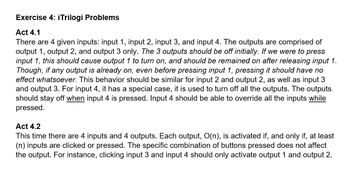Question
Please do not only give the step by step answer, but also give the ACTUAL ladder logic solution diagram for both acts. Software used is iTrilogi. (Please show PROPER IMPLEMENTATION ON ITRILOGI or similar programs. Do not use ai)

Transcribed Image Text:Exercise 4: iTrilogi Problems
Act 4.1
There are 4 given inputs: input 1, input 2, input 3, and input 4. The outputs are comprised of
output 1, output 2, and output 3 only. The 3 outputs should be off initially. If we were to press
input 1, this should cause output 1 to turn on, and should be remained on after releasing input 1.
Though, if any output is already on, even before pressing input 1, pressing it should have no
effect whatsoever. This behavior should be similar for input 2 and output 2, as well as input 3
and output 3. For input 4, it has a special case, it is used to turn off all the outputs. The outputs
should stay off when input 4 is pressed. Input 4 should be able to override all the inputs while
pressed.
Act 4.2
This time there are 4 inputs and 4 outputs. Each output, O(n), is activated if, and only if, at least
(n) inputs are clicked or pressed. The specific combination of buttons pressed does not affect
the output. For instance, clicking input 3 and input 4 should only activate output 1 and output 2.
Expert Solution
This question has been solved!
Explore an expertly crafted, step-by-step solution for a thorough understanding of key concepts.
Step by stepSolved in 2 steps

Knowledge Booster
Similar questions
- It is expected that you would be able to define System Dynamics independently. Reinforcement and balancing loops should preferably be expressed in your own terms. What kind of mathematical equations are employed in the so-called systems dynamics procedure?arrow_forwardMake an actual code equivalent in MATLAB. Include the table showing the parameter values for each interpolate. Include graphs.arrow_forwardWhy do there always be straight lines even I have changed the parameters?arrow_forward
- No hand written solution and no img b. What is the sum of the probabilities of the pointer landing in the green, blue, yellow, and red sections? Explain.arrow_forwardShow the difference in the interaction of rules, data and answers in machine learning and classical programming.arrow_forwardUse a programming example to demonstrate the use of the Least Common Mechanism principlearrow_forward
arrow_back_ios
arrow_forward_ios